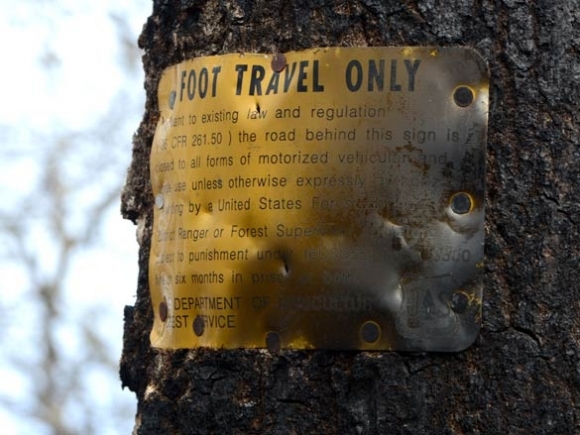Wildfire impacts range from barely there to complete char, but true effects remain to be seen

It’s a warmer-than-average January day, the contours of the mountains visible from the highway beneath a thin covering of leafless tree branches under a half-blue sky. A U.S. Forest Service Jeep travels west on U.S. 74, bypassing Franklin and hanging a right for the winding road that leads to Wayah Bald.
The vehicle pauses for a moment as it traverses a valley framed by Wayah’s upward-reaching face. The slope is mottled with patches of darkness that could almost pass for cloud shadows.
They’re burn scars.
Of the roughly 48,000 acres of wildfire that emanated from the national forests west of Asheville this fall, the area around Wayah Bald is perhaps the most accessible spot that was subject to severe burning. Here, 100-foot flames torched the landscape before changes in topography forced things to calm down.
SEE ALSO: FAQ: The effects of WNC’s 2016 fire season
Related Items
 Wayah Bald
Wayah Bald
The fire makes its presence felt gradually as the Jeep climbs the gravel road en route to the parking area. Patches of leaf litter have disappeared, consumed by a low-intensity, creeping burn. The fire didn’t have the strength to jump the road, but on the east side stumps and tree bases are charred here and there, the ground blackened in places. It’s the kind of burn that will disappear without a trace in the space of a year or so, its effects invisible to the untrained eye.
As the road climbs through a series of hairpin turns, however, the evidence of a gently licking fire gives way to the remains a full-on inferno.
Entire trees stand bare, uniformly black from top to bottom. What had been a rhododendron thicket persists as a tangle of twisted, charred arms. The ground is black and crispy, eliciting a satisfying crunch when stepped upon. More than a month after the fire was defeated, the smell of ash hangs in the air, the branches making charcoal etchings on any patch of skin or fabric that would chance to brush against them.
“So, have you seen any orcs yet?” Forest Service botanist Gary Kauffman jokes to his colleague Cathy Dowd, public information officer for the forest.
He’s scrambled down the slope a ways to test the soil for its ability to absorb water. Sometimes, fire can heat the soil enough that it repels water — a condition called hydrophobocity that creates risk of landslides and flooding in the face of heavy rain. In a survey that Kauffman and a team of other specialists completed immediately after the fires, all the locations they tested exhibited some level of hydrophobocity.
This time around, Kauffman calls up the slope with some good news. The dribbling of water he’d released into the soil took a little longer to absorb than you might expect, but it did absorb. That impermeable layer he’d observed a month ago seemed to be breaking down.
Kauffman returns uphill, the same way the fire came when it roared up to Wayah Bald. Fire travels faster uphill, rising flames preheating the fuels above them. This blaze was encouraged by winds that wafted it stronger and stronger — the perfect scenario for an intense fire. Most of the trees up here will probably die, Kauffman says. But maybe not the shrubs, whose roots seem to be mostly intact.
“What may result from this is a heath bald,” Kauffman says. “It’s much harder because of all the rhododendron for trees to come up through, so it may be this dense thicket with just a few trees.”
The 60-foot Wayah Bald Tower is still standing, its stone walls free of char. But where it was once capped by a wooden roof, an array of interpretive signs annotating the view, the tower is bare. The fire consumed all of those burnable materials — likely the result of an escaped ember, Kauffman theorizes, since there’s no evidence of flames licking the sides of the structure.
The Appalachian Trail heads north behind the tower, the blackened remains of an azalea patch quickly giving way to a forest that obviously escaped the fate afforded the dead trees at the summit. The char becomes spottier. There are some burned stumps, some trees blackened at the base, mountain laurels whose evergreen leaves hang dead and brown. But at the same time, leaves and sticks are still visible on the ground, and moss still grows green on logs and rocks. A test for hydrophobocity yields negative results.
“At this point, the fire was starting to go out,” Kauffman explains. “Even though there was continuous fuel, it didn’t burn.”
The trail crosses a private, dirt road, and so does the fire — but not without sacrificing another level of intensity. And as the trail continues parallel to the road for a piece, it’s apparent that the fire wasn’t strong enough to jump the trail after already having jumped the road.
From this vantage point, the burn looks about like it does in the majority of the affected acres. According to the Forest Service’s Burned Area Report — a document that Kauffman helped complete — the burn severity for 98 percent of the 35,953 acres evaluated for the report ranged from unburned to low, with only 1 percent experiencing moderate burn and less than 1 percent experiencing a high-burn severity.
Tellico Gap
Tellico Gap, where the Jeep heads next, is somewhere in that low to moderate range. The usual layer of fallen leaves mostly absent, the ground looks a lot darker than you’d expect for a deciduous forest floor. It’s apparent where the heat was concentrated, as rhododendron leaves are brown below about head height and green higher up. However, the area is far removed from the obvious inferno that swept through Wayah. Not even the leaf litter is burned uniformly, with islands of unburned ground floating amid larger patches where bare soil is visible.
Kauffman does a couple hydrophobocity tests — things are absorbing just fine in this area, it seems — and keeps an eye out for garlic mustard. The invasive herb has been known to grow in areas nearby, and the bare ground exposed by the fire could create opportunity for it to spread. The aggressive plant might then displace native species, which are better sources of food for insects and wildlife.
The Forest Service secured $55,000 to treat areas for invasive plants across nine different wildfire areas in Western North Carolina. Kauffman was keeping his eyes open, as it’s easy to pull the weeds when they’re small in size and number. If the problem proves to be bigger than just a few plants, the earlier in the season it’s dealt with, the better.
“If you treat it early, you get less unnecessary contamination of other herbs because they’re not up yet,” he explained.
Luckily, garlic mustard doesn’t appear to be a problem at Tellico — yet. He’ll be back to check again before the winter is out.
Nantahala Gorge
Winding down from Tellico and through the Nantahala community toward Almond, evidence of fire recedes and then disappears, replaced by the peaceful scenes of a rural region where life flows along largely independent of the outside world.
But then the road turns toward the Nantahala Gorge, and gazing up the rugged mountainsides reveals that the fire touched here, too. Dead treetops populate the peak, and closer to the road the telltale blackness scatters along the forest floor and climbs up the bases of trees.
“Of anywhere you would not expect it to burn, it would be here,” Kauffman says.
The gorge is moist, humidified by the Nantahala River running through it. And it’s protected by steep slopes on either side — fire would have to climb downhill for quite a ways to reach the bottom, and fires typically have a hard time retaining their fury on the descent.
The Jeep seeks out a pull-off, and its occupants scramble up the side of the gorge. Even getting off the road requires a running start, and then a half-climbing hike as fingernails grip the dirt. Looking down, the direction from which the fire came is obvious. The trees look untouched from the bottom of the gorge, but look downslope and you can see that the bases are charred from the uphill side.
It’s here that Kauffman finds the first truly hydrophobic soil of the day, present in a small patch of harshly blackened ground surrounded by fuel that was barely consumed. The water droplet flops over, coating itself with grainy soil and laying there, blob-like.
Kauffman and Dowd also spend a minute searching for snails. They’re all over, empty shells bleached white. But they don’t find any representing the one species they’re looking for, called the noonday snail. The species has been documented only on a 99-acre area of the Nantahala Gorge, and 85 percent of those acres were burned in the fire.
“Most creatures could get away from the fire,” Kauffman says. “Snails, it’s a little bit harder to move.”
But when it comes to the snails, as to most everything else associated with impacts from the fires, Kauffman’s firmest conclusion is that we’ll just have to wait and see.
Fires can be good. They can reinvigorate plant life, improve habitat for wildlife, and reduce fuel loads so that the chance of wildfire stays lower going forward. But they can also cause issues, as in the case of the noonday snail, or when it comes to creating hazards from fallen trees, flooding, invasive species or loss of structures.
Often, it’s impossible to really ferret out what those impacts will be until some time has passed. Kauffman recalls the surprising outcome of the Silvermine Fire that burned in Madison County during the spring of 2016.
“It looked like while the fire was hot, it didn’t have really high-intensity flames and it didn’t char a large amount of the tree, nor did it seem to affect the soil layer, but a lot of the trees for 100 acres are dead,” Kauffman said.
From snails to trees to trails, the ultimate verdict will likely come at the end of a waiting game that extends through the next season.
“For most things, it’s too early to tell,” Kauffman said.









